Text
Hugo continues to use Valjean’s escape as an opportunity to lovingly describe the streets of Paris, detailing aspects such as the habit of not lighting street lanterns during moonlit nights. He provides another lesson in Parisian topography around the Pont d’Austerlitz and even mentions the inscription on the Goblet potteries, seemingly just for the sake of it.
While Hugo enjoys leisurely wandering the streets of Paris, Valjean feels increasingly uncomfortable in this urban environment. The bustling city is not his natural habitat, he “shuddered like the wild beast which is recaptured.” His instinct drives him towards the marshes and uninhabited areas on the right bank of the Seine.
34 notes
·
View notes
Text
Les Mis Canon-era Paris Photographs: Jean Valjean and Cosette’s route to escape Javert, in Pictures!

Jean Valjean's escape through Paris is Victor Hugo's way of mourning the Paris he knew from before his exile, the Paris before the modern renovations.
Hugo wrote Les Mis from exile in Guernsey, at the same time as Paris was undergoing a series of massive renovations. The "Old City" of medieval Paris that Hugo loved was being replaced by the “New City" of Baron Haussman. The dark medieval labyrinth lit by oil lamps was being replaced by modern wide streets and standardized architecture lit by gas lamps. Victor Hugo is nostalgic for the Paris he remembers before his exile-- so Jean Valjean is able to escape Javert using things unique to the Old City. He escapes through a labyrinth of tiny medieval streets in a neighborhood Hugo claims was destroyed during the renovations; he climbs over the convent wall using the rope from an oil lamp, the very oil lamps that were being replaced by the more modern gas lanterns. The dark maze hides him from police surveillance in a way modern streets cannot.
A man named Charles Marville photographed Paris shortly before many (though not all) of the renovations occurred. In this post I'll go through all the different streets mentioned in the Valjean-Javert Paris chase chapters, and provide Marville's photographs whenever they the image has been labeled with the name of the street. Note that there may be some inaccuracies. Some street names changed over time.
Here is a map of what the chase looks like, taken from the book "Paris in the Times of Victor Hugo."
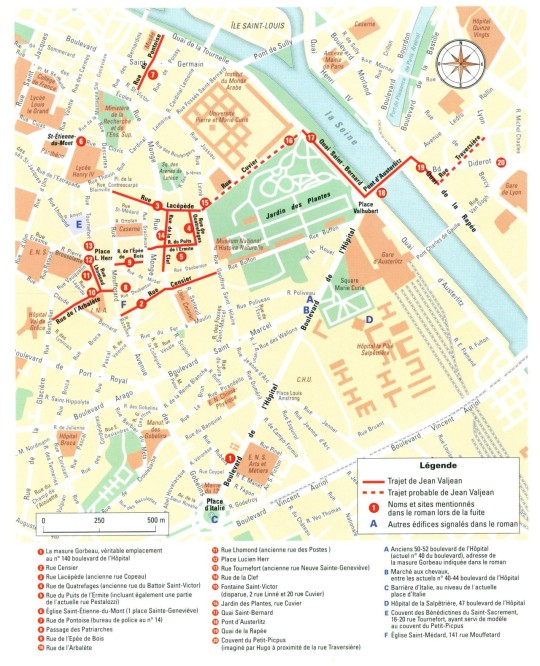
A quick overview: Jean Valjean starts in a slummy half-built suburban area. This area is highly associated with the King; the royal Jardin des Plantes is nearby, and King Louis XVIII often rides by in his carriage during the afternoons. After travelling down a bunch of streets, "zigzagging" back and forth, Jean Valjean decides to cross the Seine over the Bridge of Austerlitz (a bridge named after one of Napoleon's victories.) Then he reaches the areas of the city near the Faubourg Saint Antoine that are more associated with working class rebellion. From there he enters a dark isolated half-built medieval neighborhood near marshes and timberyards, with narrow mazey alleyways, that Hugo mostly made up. Hugo pretends this medieval neighborhood used to exist, but was destroyed like many others during the recent renovations. Now that we've gotten the overview out of the way, let's go more specific!
The chase starts out in "the old quarter of the Marche aux Chevaux." At the time, this was a less inhabited and poorer area of Paris; it's described as basically a slum. Here are some of Marville's photographs :

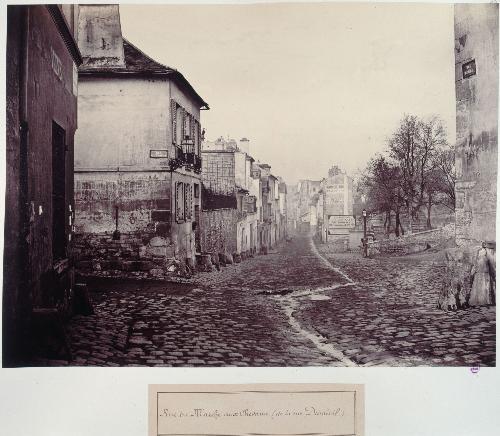
Then we're told "Jean Valjean described many and varied labyrinths in the Mouffetard quarter, which was already asleep, as though the discipline of the Middle Ages and the yoke of the curfew still existed. He combined in various manners, with cunning strategy, the Rue Censier:"
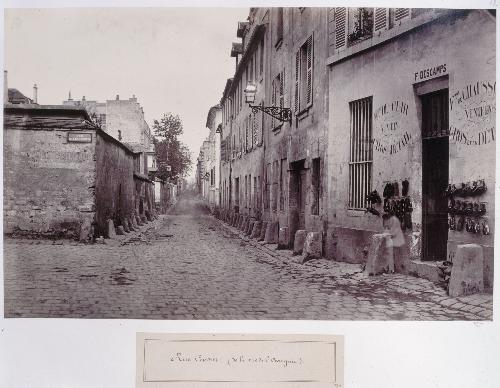
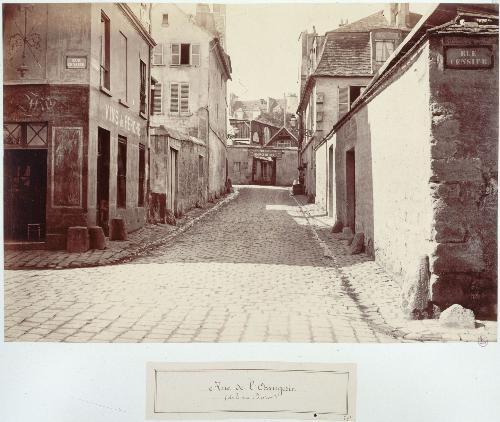


"and the Rue Copeau," (according to the map I linked earlier, the Rue Copeau is now the Rue Lacepede. Here is Marville's pic:)

"the Rue du Battoir-Saint-Victor and the Rue du Puits l’Ermite. There are lodging houses in this locality, but he did not even enter one, finding nothing which suited him. He had no doubt that if any one had chanced to be upon his track, they would have lost it."
"As eleven o’clock struck from Saint-Étienne-du-Mont:" (note: this refers to the church of Saint-Etienne)

"he was traversing the Rue de Pontoise, in front of the office of the commissary of police, situated at No. 14." (Jean Valjean sees Javert and the police following him on this street, because they're visible in the light of the lantern from the police station.)
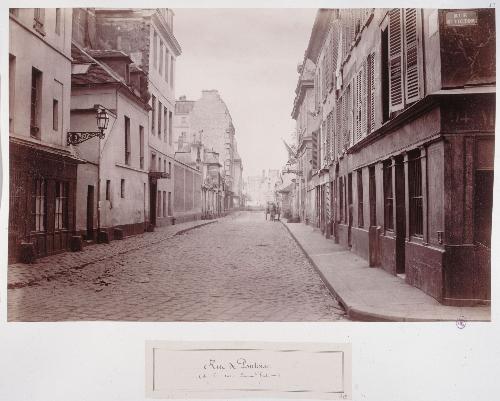
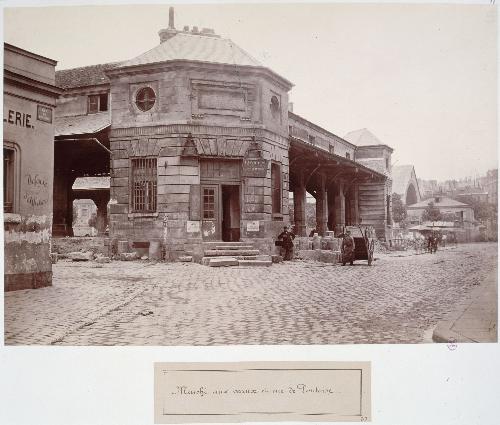
"He took a circuit, turned into the Passage des Patriarches, which was closed on account of the hour,"
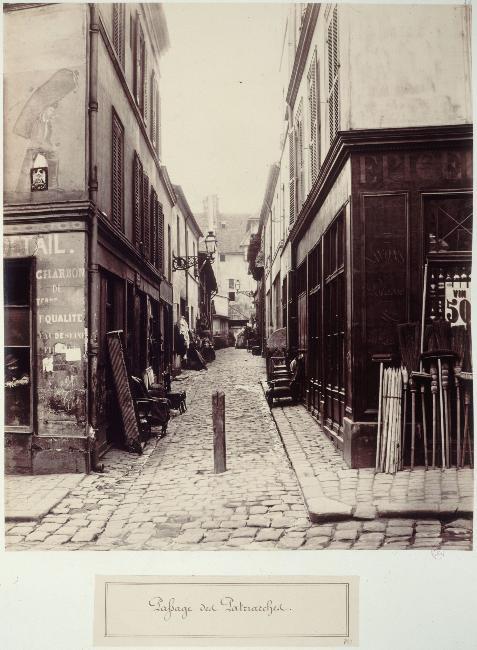
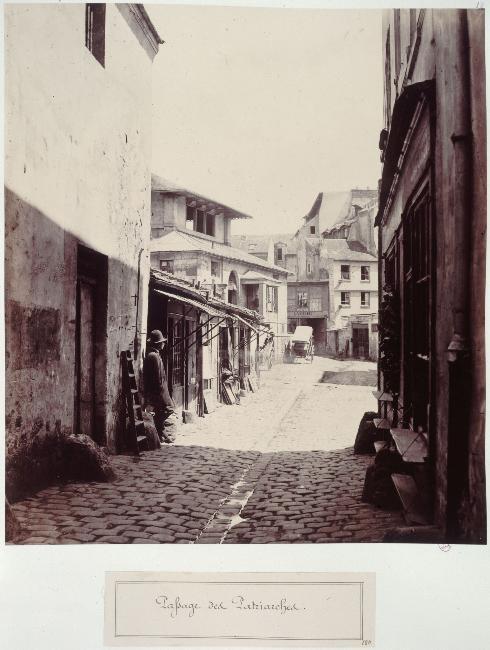
"strode along the Rue de l’Épée-de-Bois

and the Rue de l’Arbalète, and plunged into the Rue des Postes."




"At that time there was a square formed by the intersection of streets, where the College Rollin stands to-day, and where the Rue Neuve-Sainte-Geneviève turns off." (Note: these streets are labeled Montagne-Sainte-Geneviève, but not Neuve-Sainte-Geneviève, so they may be different streets! But I'm putting them here anyway.)
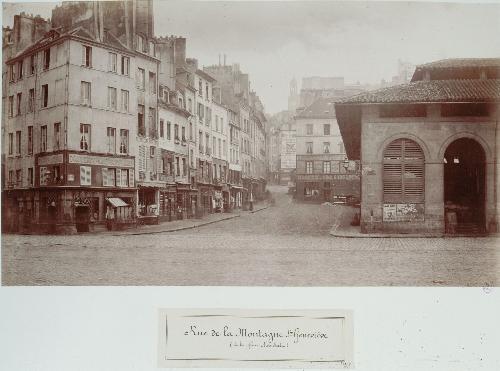


"It is understood, of course, that the Rue Neuve-Sainte-Geneviève is an old street, and that a posting-chaise does not pass through the Rue des Postes once in ten years. In the thirteenth century this Rue des Postes was inhabited by potters, and its real name is Rue des Pots." (Annotation: Hugo's bein silly and making little puns. He's snarkily pointing out the "new saint-genevieve street" is old, and the post street rarely has post-chaises/carriages go through it.)
(Jean Valjean hides in the shadows and watches to see who shows up in this big square intersection of streets. In the moonlight, he recognizes Javert.)
"He slipped from under the gate where he had concealed himself, and went down the Rue des Postes (which I shared a picture of previously), towards the region of the Jardin des Plantes." (Note: the Jardin des Plantes is a royal garden. Here is a modern photo from Wikipedia.)

"He left behind him the Rue de la Clef,

"then the Fountain Saint-Victor, skirted the Jardin des Plantes by the lower streets, and reached the quay. There he turned round. The quay was deserted. The streets were deserted. There was no one behind him. He drew a long breath.
He gained the Pont d’Austerlitz."
(The Pont d'Austerlitz, named after Napoleon's victory at the battle of Austerlitz, is a very famous bridge. Marville has no photographs but here's an 1830 engraving:)

"The bridge once crossed, he perceived some timber-yards on his right. He directed his course thither. In order to reach them, it was necessary to risk himself in a tolerably large unsheltered and illuminated space. He did not hesitate. Those who were on his track had evidently lost the scent, and Jean Valjean believed himself to be out of danger. Hunted, yes; followed, no."
Here's the quai by the pont-au-change-- a different quai, but gives you an idea of what the areas around the Seine often looked like.
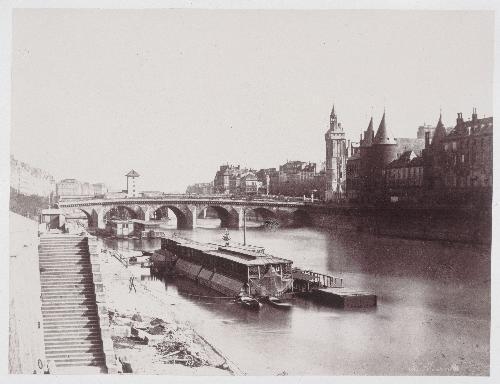
(Then Jean Valjean sees Javert and the other police on the Bridge of Austerlitz, following him. He hurries towards the darker alleys of the city.)
"A little street, the Rue du Chemin-Vert-Saint-Antoine, opened out between two timber-yards enclosed in walls. This street was dark and narrow and seemed made expressly for him."
Here's an abandoned timber-yard-ish looking picture:

But Marville has no photographs of this street. I'd have to double check, but iirc this is the part where Hugo starts to 'make up' more street layouts. I wouldn't be surprised if this street really WAS made expressly for him (meaning Hugo made it up.)
"The point of Paris where Jean Valjean found himself, situated between the Faubourg Saint-Antoine and la Râpée, is one of those which recent improvements have transformed from top to bottom,—resulting in disfigurement according to some, and in a transfiguration according to others. The market-gardens, the timber-yards, and the old buildings have been effaced. To-day, there are brand-new, wide streets, arenas, circuses, hippodromes, railway stations, and a prison, Mazas, there; progress, as the reader sees, with its antidote."
(Here Hugo talks about the Haussman renovations directly, claiming that if his street layouts are "inaccurate" it's because these are some of the Old Medieval Streets that were razed during Paris's recent renovations. He goes on for a while comparing Petit-Picpus to various other areas that were changed during the renovations.)
"Le Petit-Picpus, which, moreover, hardly ever had any existence, and never was more than the outline of a quarter, had nearly the monkish aspect of a Spanish town. The roads were not much paved; the streets were not much built up. (....) Such was this quarter in the last century. The Revolution snubbed it soundly. The republican government demolished and cut through it. Rubbish shoots were established there. Thirty years ago, this quarter was disappearing under the erasing process of new buildings. To-day, it has been utterly blotted out."
The Petit-Picpus, of which no existing plan has preserved a trace, is indicated with sufficient clearness in the plan of 1727, published at Paris by Denis Thierry, Rue Saint-Jacques, opposite the Rue du Plâtre;

and at Lyons, by Jean Girin, Rue Mercière, at the sign of Prudence.
Petit-Picpus had, as we have just mentioned, a Y of streets, formed by the Rue du Chemin-Vert-Saint-Antoine, which spread out in two branches, taking on the left the name of Little Picpus Street, and on the right the name of the Rue Polonceau. The two limbs of the Y were connected at the apex as by a bar; this bar was called Rue Droit-Mur.
The Rue Polonceau ended there; Rue Petit-Picpus passed on, and ascended towards the Lenoir market. A person coming from the Seine reached the extremity of the Rue Polonceau, and had on his right the Rue Droit-Mur, turning abruptly at a right angle, in front of him the wall of that street, and on his right a truncated prolongation of the Rue Droit-Mur, which had no issue and was called the Cul-de-Sac Genrot."
Here is @everyonewasabird's attempt to puzzle this out:

It was here that Jean Valjean stood."
Then Jean Valjean escapes by pulling down an old oil lantern, strung up by ropes. Hugo notes that this would have been "impossible if the streets were lit with gas, the way they would be after the renovations. This picture shows an old oil lamp strung up by ropes:

Finally, Jean Valjean climbs over the wall into the Petit-Picpus convent. This convent is fictional. Hugo pretends it used to exists but is no longer around-- another relic of the early 19th century that has been lost over time.
TLDR:
Jean Valjean's escape through Paris is Hugo way of mourning the Paris he knew from before his exile, the Paris before the modern renovations. To quote Volume 2 Book 5 Chapter 1:
The author of this book, who regrets the necessity of mentioning himself, has been absent from Paris for many years. Paris has been transformed since he quitted it. A new city has arisen, which is, after a fashion, unknown to him. There is no need for him to say that he loves Paris: Paris is his mind’s natal city. In consequence of demolitions and reconstructions, the Paris of his youth, that Paris which he bore away religiously in his memory, is now a Paris of days gone by. He must be permitted to speak of that Paris as though it still existed. It is possible that when the author conducts his readers to a spot and says, “In such a street there stands such and such a house,” neither street nor house will any longer exist in that locality. Readers may verify the facts if they care to take the trouble. For his own part, he is unacquainted with the new Paris, and he writes with the old Paris before his eyes in an illusion which is precious to him. It is a delight to him to dream that there still lingers behind him something of that which he beheld when he was in his own country, and that all has not vanished. So long as you go and come in your native land, you imagine that those streets are a matter of indifference to you; that those windows, those roofs, and those doors are nothing to you; that those walls are strangers to you; that those trees are merely the first encountered haphazard; that those houses, which you do not enter, are useless to you; that the pavements which you tread are merely stones. Later on, when you are no longer there, you perceive that the streets are dear to you; that you miss those roofs, those doors; and that those walls are necessary to you, those trees are well beloved by you; that you entered those houses which you never entered, every day, and that you have left a part of your heart, of your blood, of your soul, in those pavements. All those places which you no longer behold, which you may never behold again, perchance, and whose memory you have cherished, take on a melancholy charm, recur to your mind with the melancholy of an apparition, make the holy land visible to you, and are, so to speak, the very form of France, and you love them; and you call them up as they are, as they were, and you persist in this, and you will submit to no change: for you are attached to the figure of your fatherland as to the face of your mother.
114 notes
·
View notes
Text

Oh good! Fantine's happy. It was a tough story but we got there! Good job everyone, novel's over, everyone go home!!!!!
307 notes
·
View notes
Text
And another one. Years of missed plot rolling out of me :-)
I'm having fun
#loved this chapter#eponine and combeferre is such an unexpected yet satisfying team combo#love it#enjonine#city of glass#les miserables au#I firmly believe every les mis fan should read this even if you don’t ship enjonine
2 notes
·
View notes
Text
Dracula Daily: Ah yes, letters from my good friend Jonathan Harker as he travels abroad on his realty adventures! This Dracula guy is giving a lot of red flags, but no matter. Give me more paprika hendl recipes. :)
Les Mis Letters: Victor Hugo spams your inbox every day infodumping about his hundreds of OCs he likes to put through Les Miseries, such as a nice bread thief DILF with severe PTSD, a canonically ugly furry cop with an Authority kink, and a Bishop we get the entire lore for in the beginning and barely hear from again. Sometimes he goes on lengthy tangents about the Battle of Waterloo or the Parisian sewer system. Also Revolution and ACAB. *Pokémon voice* "Who's that buff old man? That's right! It's John McJohn!" Thank you, Victor, but please, it's 10am.
169 notes
·
View notes
Text
Marius is stronger than me because if my entire friend group except for me tragically died at a failed rebelion I would feel so left out of the group,
the Romanticism equivalent of your friends going to the mall without you
268 notes
·
View notes
Text
in my top 10 les mis moments: marius suggesting that if enjolras had also seen cosette he too might have been struck by a moment of breathless delight or whatever the fuck and enjolras straight up SCOFFING
837 notes
·
View notes
Text
90% of Les Amis have never worked a customer service job like no wonder they’re “for the people” send post
242 notes
·
View notes
Text
Riding the wave as long as it lasts
#SO EXCITED TO READ THIS#enjonine#city of glass#les miserables au#currently rereading and loving life now that this fic is back#happy days
2 notes
·
View notes
Text
Never thought this day would come. And probably, neither did you. Well. Miracles happen. I'm back in the game.
Update time:
#one of my absolute favourites has returned#currently rerearing and obsessed once again#enjonine#city of glass#les miserables#currently shedding happy tears
4 notes
·
View notes
Text
climb ev’ry mountain more like go climb christopher plummer you foolish girl
55 notes
·
View notes
Text
So many things in Les Mis makes sense when you realize half the characters are making decisions on little to no sleep….it’s literally just that one meme

484 notes
·
View notes
Text
upon meeting marius courfeyrac calls dibs on him in front of all les amis and everyone is like… courfeyrac NOBODY but you wants him
415 notes
·
View notes
Text
Les Miserables Timeline (absurdly detailed)
To save myself time looking stuff up. Includes characters’ birthdates, and Tome-Book-Chapter references where applicable. I may make a separate hour-by-hour barricade timeline at some point. Corrections and additions are most welcome.
Keep reading
501 notes
·
View notes
Text
My favorite bit of dialogue from Les Mis 1.1.10 is from the exchange where the Bishop and the revolutionary are discussing the death of one of the Royal children during the revolution:
“I will weep with you over the children of kings, provided that you will weep with me over the children of the people.”
“I weep for all,” said the Bishop.
“Equally!” exclaimed conventionary G——; “and if the balance must incline, let it be on the side of the people. They have been suffering longer.”
I don't know, I think it's a perfect encapsulation of why the bishop's "All lives matter, we should feel sorry for Everyone equally" philosophy was incomplete. The bishop's privileged aristocratic background means he doesn't necessarily understand how to take this systemic inequality into account when choosing who to grieve and who to forget. The death of a king's child is a horrible tragedy beyond words and proof that the rebels are heartless monsters.....but the deaths of thousands of non-royal children under the reign of tyrannical kings, as a direct result of those kings' policies, are quietly forgotten by him.
Until the Conventionary pointed it out, the Bishop couldn't see that "weeping for all" isn't enough when some lives are treated as if they're inherently far more expendable.
It also makes me think of the fact that there are, for example, so many pieces of media about the suffering of Poor Girlboss Marie Antoinette to the point where its almost its own subgenre. And there's that entire subgenre like A Tale of Two Cities/The Scarlet Pimpernel that's about how Hard it was to be an aristocrat around dirty deranged French Revolution peasants. And period/fantasy media as a whole loves to focus on the struggles of royalty and the upper class. Like yeah, everyone can experience pain/trauma regardless of their social class- and yeah theoretically we should weep for everyone's pain equally. But as the Conventionary points out.... it's interesting how the pain of one small group of privileged people is treated with far much more importance, and is focused on so much more often, while the pain of a much larger group of people is utterly forgotten. "Weeping for all" often only means, weeping for the powerful and important people who were considered worthy of being remembered. And in that vein I think it's relevant that multiple main characters in Les Mis end up being buried in nameless or unmarked graves.
1K notes
·
View notes
Text
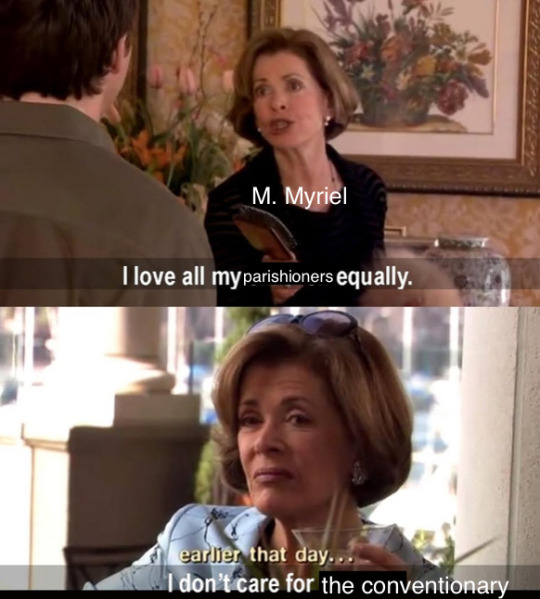
Personal growth? In *our* bishop? It's more likely than you think-
267 notes
·
View notes
